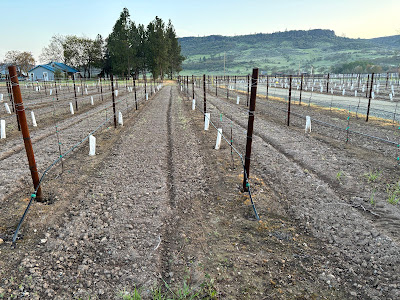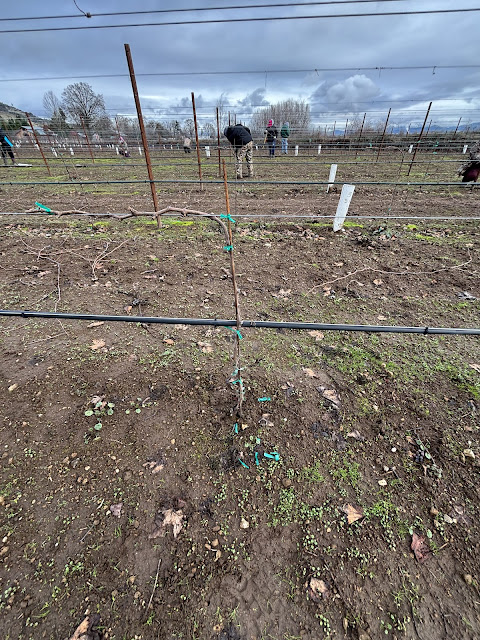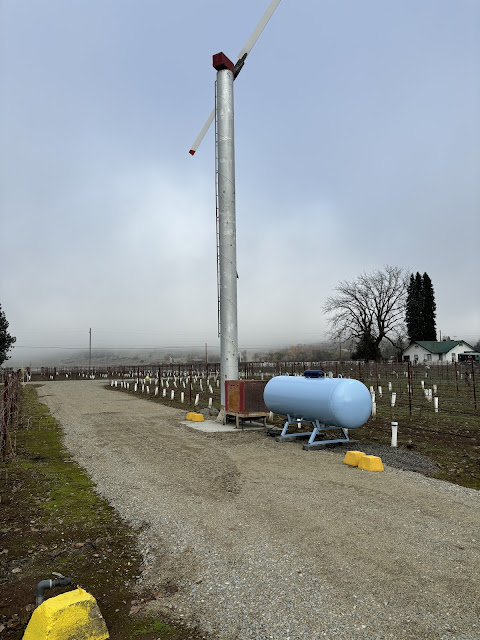Grape vines don't know anything.
And yet they know exactly where they are, what time it is, and what they are supposed to do.
April is a time to wake up, grow buds, start leaves, grow vines, and get ready to bear fruit.
The photo is a slightly better than average plant in a vineyard of about 6,000 plants. It happens to be one of about 3,000 Pinot Noir plants, which as a group look a little healthier than the 1,500 Cabernet Sauvignon and 1,500 Malbec plants. I am growing what a local winery, Valley View Vineyards, said they would be most likely to buy if I get harvestable grapes. This will be the third year, and I might get enough grapes for a small harvest.
The plants went dormant in November. The field looked like this after a freezing rain.
Then, in late December, experienced pruners cut the plants down to a single stalk, which goes up vertically until it reaches the cane wire at 31 inches height. They then bend that stalk 90 degrees at the cane wire to look like this. It takes five or six ties to shape the plant.
Over the past ten days plants first grew buds, then leafed out. Look closely. The buds are a little bigger than a pencil eraser. This is how they looked a few days ago.
The primary task at hand for me is frost control. My vineyard is on a bench of pumice soil about 15 feet above the flood plain of the Rogue River. Cold air settles down, and, like water, cold air seeks the lowest spot. Cold air passes over my vineyard on the way to the lowest spot, the Rogue River itself. It means I get 30 degree frosts even when it is 36 degrees and higher in Medford. I attempt to protect these delicate buds by stirring up the air with these wind machines.
They had been set to turn on at 33 degrees. I reset them to turn on at 34 degrees. Cold frosty air seems to settle along the ground, so even when the air at a four-foot elevation, where the machine sensors are, measures 33.2 degrees, it doesn't trigger the machine to start.
 |
| White frost on the tilled ground |
Frost control is tricky and uncertain. Wind machines work by mixing frosty air on the ground with the warmer air higher up. But if there is a genuine cold front, the machines are useless, because the air is cold all the way up. A frost would kill the buds.
Grapes are the opposite of melons in some ways. Melon plants are delicate. They want to die. The task is to nurture the delicate things, coax them to stay alive, grow big vines, and therefore get big beautiful melons come August. Grapes are different. Once started, they seem to want to grow vigorously, against nearly every injury. Most vineyard work is removal. Remove those suckers at the base of the plant (visible in the first photo), and keep doing it all summer. Keep removing the top growth and place the vines within the top double rows of wire at one foot and two feet above the cane wire. Prune. Shape. Prune again. There is lots of summer work.
I used to be okay bending over repeatedly. Not anymore. I stay busy doing weed control, which I can do partly with a tractor and tiller and partly by walking up and down the rows hoeing weeds around the plants, which I can do standing upright.
A disease problem emerged within the Cabernet Sauvignons: crown gall. It is that brown woody swelling. It isn't good, but it isn't fatal, either. It complicates pruning because pruning clippers can spread the disease from one plant to another. At this point, I guess I just live with it. The plants do.
I am doing a little to promote a bit of special-ness to this vineyard. It is on a unique soil type: ground-up pumice. Pumice soil drains rapidly. It is the consistency of ground sugar, and it does down 20 feet or more. When it is tilled it is as fine as powdered sugar or talc. It means the fine capillary roots of the plants will be able to absorb micronutrients and flavor tones that aren't available in heavier soils. I am making it a selling point for the grapes.
The farm reminds me of the big picture, far away from the noise of daily politics. Two centuries ago the land was an abundant home to local indigenous people. The salmon came to them. (My father said that in his boyhood in the 1920s he could catch them on the riffles with a pitchfork.) A hundred years ago it was home for my parents and grandparents. I am farming it now. A hundred years from now, the land will still be there and someone will be trying to coax something from it. April will come every year.










6 comments:
Trump reminds me of Shelley's great poem, Ozymandias. Your work is timeless and makes an actual contribution.
I suspect the earth will survive humans even if we are able to avoid extinction. Farming has a real down to earth quality that is fulfilling. That’s why my tomatoes are grown even though it is cheaper to buy them.
Are the grape plants grown on grafts, so that the suckers are not really grape plants, but rather part of the graft plant? (Like a plum tree.)
How much "shrinkage" do you get from birds? When I grew grapes, then the birds stole all the fruit.
Nearly all the plants are on their own roots. One section of the Pinot Noirs are grafted but was careful not to use those suckers. The Pinot noirs have outgrown that problem and are essentially 100 percent grown healthy plants. I will see about bird damage. Two owl families live nearby and they seem to coexist with hawks. Birds don’t damage the 4 big grape plants I planted a decade ago for shade. Birds did destroy all the fruit on a single bing cherry tree I had. We will see. Farming is hard and there is a lot of waste.
So happy to see a post about something other than politics!
It is mostly a political blog. But also farming. Downsizing. Expats. And being age 75. Send a nonpolitical proposed guest post.
Post a Comment